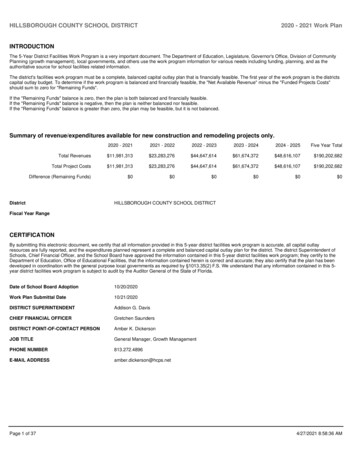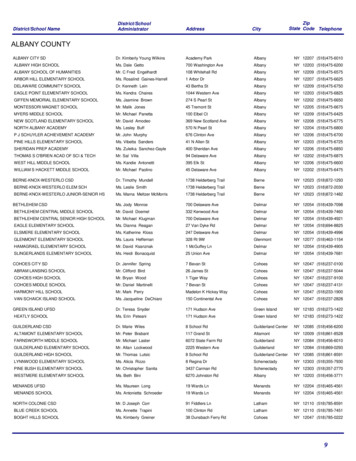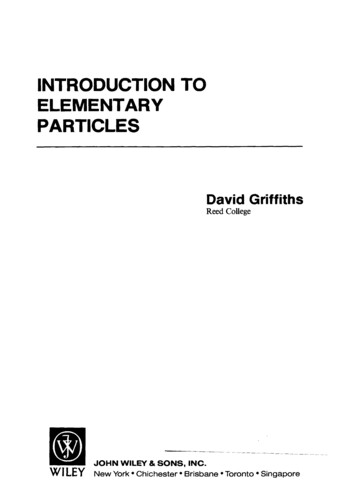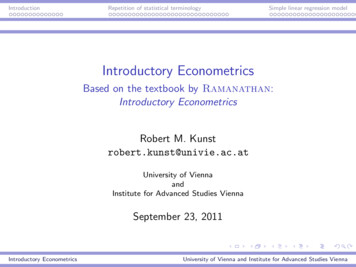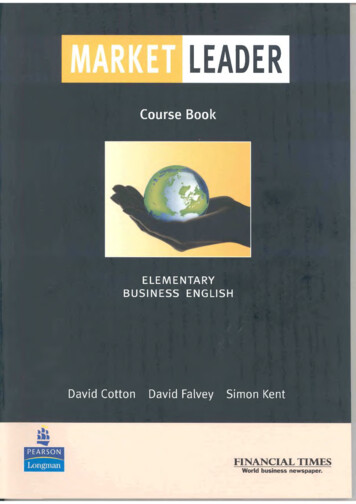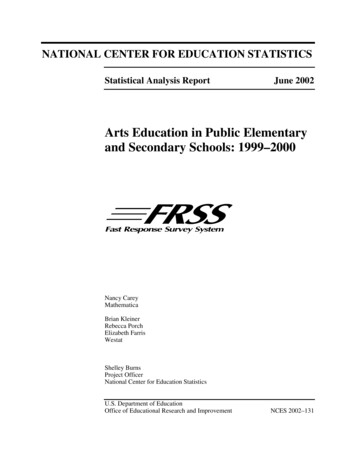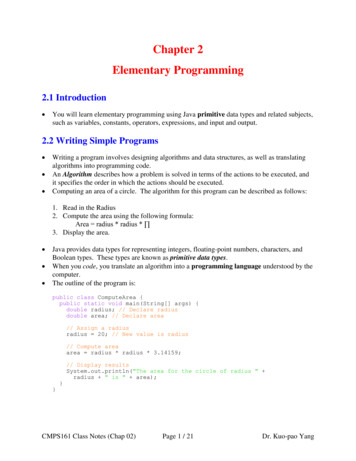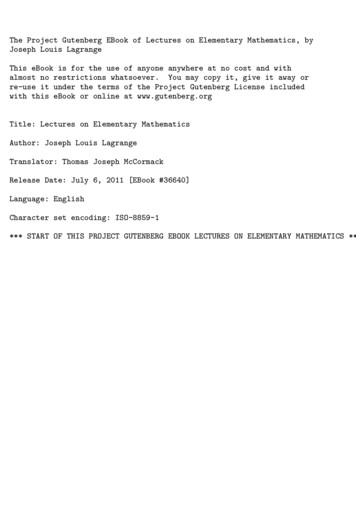
Transcription
An Introductory Course in ElementaryNumber TheoryWissam Raji
2PrefaceThese notes serve as course notes for an undergraduate course in number theory. Most if not all universities worldwide offer introductory courses in numbertheory for math majors and in many cases as an elective course.The notes contain a useful introduction to important topics that need to be addressed in a course in number theory. Proofs of basic theorems are presented inan interesting and comprehensive way that can be read and understood even bynon-majors with the exception in the last three chapters where a background inanalysis, measure theory and abstract algebra is required. The exercises are carefully chosen to broaden the understanding of the concepts. Moreover, these notesshed light on analytic number theory, a subject that is rarely seen or approachedby undergraduate students. One of the unique characteristics of these notes is thecareful choice of topics and its importance in the theory of numbers. The freedomis given in the last two chapters because of the advanced nature of the topics thatare presented.Thanks to professor Pavel Guerzhoy from University of Hawaii for his contribution in chapter 6 on continued fraction and to Professor Ramez Maalouf fromNotre Dame University, Lebanon for his contribution to chapter 8.
Contents1Introduction71.1Algebraic Operations With Integers . . . . . . . . . . . . . . . .81.2The Well Ordering Principle and Mathematical Induction . . . . .91.2.1The Well Ordering Principle . . . . . . . . . . . . . . .101.2.2The Pigeonhole Principle . . . . . . . . . . . . . . . . .101.2.3The Principle of Mathematical Induction . . . . . . . .10Divisibility and the Division Algorithm . . . . . . . . . . . . . .131.3.1Integer Divisibility . . . . . . . . . . . . . . . . . . . . .131.3.2The Division Algorithm . . . . . . . . . . . . . . . . . .151.4Representations of Integers in Different Bases . . . . . . . . . . .161.5The Greatest Common Divisor . . . . . . . . . . . . . . . . . . .201.6The Euclidean Algorithm . . . . . . . . . . . . . . . . . . . . . .241.7Lame’s Theorem . . . . . . . . . . . . . . . . . . . . . . . . . .281.32Prime Numbers312.1The Sieve of Eratosthenes . . . . . . . . . . . . . . . . . . . . . .312.2The infinitude of Primes . . . . . . . . . . . . . . . . . . . . . .342.3The Fundamental Theorem of Arithmetic . . . . . . . . . . . . .352.3.1The Fundamental Theorem of Arithmetic . . . . . . . . .362.3.2More on the Infinitude of Primes . . . . . . . . . . . . . .39Least Common Multiple . . . . . . . . . . . . . . . . . . . . . .412.43
4CONTENTS2.5Linear Diophantine Equations . . . . . . . . . . . . . . . . . . .432.6The function [x] , the symbols ”O”, ”o” and ” ” . . . . . . . . . .462.6.1The Function [x] . . . . . . . . . . . . . . . . . . . . . .462.6.2The ”O” and ”o” Symbols . . . . . . . . . . . . . . . . .47Theorems and Conjectures involving prime numbers . . . . . . .492.7345Congruences513.1Introduction to congruences . . . . . . . . . . . . . . . . . . . .513.2Residue Systems and Euler’s φ-Function . . . . . . . . . . . . . .573.2.1Residue Systems . . . . . . . . . . . . . . . . . . . . . .573.2.2Euler’s φ-Function . . . . . . . . . . . . . . . . . . . . .593.3Linear Congruences . . . . . . . . . . . . . . . . . . . . . . . . .593.4The Chinese Remainder Theorem . . . . . . . . . . . . . . . . .623.5Theorems of Fermat, Euler, and Wilson . . . . . . . . . . . . . .64Multiplicative Number Theoretic Functions694.1Definitions and Properties . . . . . . . . . . . . . . . . . . . . . .704.2Multiplicative Number Theoretic Functions . . . . . . . . . . . .734.2.1The Euler φ-Function . . . . . . . . . . . . . . . . . . .734.2.2The Sum-of-Divisors Function . . . . . . . . . . . . . .764.2.3The Number-of-Divisors Function . . . . . . . . . . . .774.3The Mobius Function and the Mobius Inversion Formula . . . . .794.4Perfect, Mersenne, and Fermat Numbers . . . . . . . . . . . . . .82Primitive Roots and Quadratic Residues895.1The order of Integers and Primitive Roots . . . . . . . . . . . . .895.2Primitive Roots for Primes . . . . . . . . . . . . . . . . . . . . .945.3The Existence of Primitive Roots . . . . . . . . . . . . . . . . . .985.4Introduction to Quadratic Residues and Nonresidues . . . . . . . 1055.5Legendre Symbol . . . . . . . . . . . . . . . . . . . . . . . . . . 106
CONTENTS655.6The Law of Quadratic Reciprocity . . . . . . . . . . . . . . . . . 1125.7Jacobi Symbol . . . . . . . . . . . . . . . . . . . . . . . . . . . . 116Introduction to Continued Fractions1216.1Basic Notations . . . . . . . . . . . . . . . . . . . . . . . . . . . 1226.2Main Technical Tool . . . . . . . . . . . . . . . . . . . . . . . . 1266.3Very Good Approximation . . . . . . . . . . . . . . . . . . . . . 1306.4An Application . . . . . . . . . . . . . . . . . . . . . . . . . . . 1326.5A Formula of Gauss, a Theorem of Kuzmin and Lévi and a Problem of Arnold . . . . . . . . . . . . . . . . . . . . . . . . . . . . 13378Introduction to Analytic Number Theory1377.1Introduction . . . . . . . . . . . . . . . . . . . . . . . . . . . . . 1377.2Chebyshev’s Functions . . . . . . . . . . . . . . . . . . . . . . . 1417.3Getting Closer to the Proof of the Prime Number Theorem . . . . 143Other Topics in Number Theory1518.1Cryptography . . . . . . . . . . . . . . . . . . . . . . . . . . . . 1518.2Elliptic Curves . . . . . . . . . . . . . . . . . . . . . . . . . . . 1548.3The Riemann Zeta Function . . . . . . . . . . . . . . . . . . . . 161
6CONTENTS
Chapter 1IntroductionIntegers are the building blocks of the theory of numbers. This chapter containssomewhat very simple and obvious observations starting with properties of integers and yet the proofs behind those observations are not as simple. In this chapterwe introduce basic operations on integers and some algebraic definitions that willbe necessary to understand basic concepts in this book. We then introduce theWell ordering principle which states basically that every set of positive integershas a smallest element. Proof by induction is also presented as an efficient methodfor proving several theorems throughout the book. We proceed to define the concept of divisibility and the division algorithm. We then introduce the elementarybut fundamental concept of a greatest common divisor (gcd) of two integers, andthe Euclidean algorithm for finding the gcd of two integers. We end this chapter with Lame’s Lemma on an estimate of the number of steps in the Euclideanalgorithm needed to find the gcd of two integers.7
8CHAPTER 1. INTRODUCTION1.1Algebraic Operations With IntegersThe set Z of all integers, which this book is all about, consists of all positive andnegative integers as well as 0. Thus Z is the set given byZ {., 4, 3, 2, 1, 0, 1, 2, 3, 4, .}.(1.1)While the set of all positive integers, denoted by N, is defined byN {1, 2, 3, 4, .}.(1.2)On Z, there are two basic binary operations, namely addition (denoted by )and multiplication (denoted by ·), that satisfy some basic properties from whichevery other property for Z emerges.1. The Commutativity property for addition and multiplicationa b b aa·b b·a2. Associativity property for addition and multiplication(a b) c a (b c)(a · b) · c a · (b · c)3. The distributivity property of multiplication over additiona · (b c) a · b a · c.
1.2. THE WELL ORDERING PRINCIPLE AND MATHEMATICAL INDUCTION9In the set Z there are ”identity elements” for the two operations and ·, and theseare the elements 0 and 1 respectively, that satisfy the basic propertiesa 0 0 a aa·1 1·a afor every a Z.The set Z allows additive inverses for its elements, in the sense that for everya Z there exists another integer in Z, denoted by a, such thata ( a) 0.(1.3)While for multiplication, only the integer 1 has a multiplicative inverse in thesense that 1 is the only integer a such that there exists another integer, denoted bya 1 or by 1/a, (namely 1 itself in this case) such thata · a 1 1.(1.4)From the operations of addition and multiplication one can define two otheroperations on Z, namely subtraction (denoted by ) and division (denoted by/). Subtraction is a binary operation on Z, i.e. defined for any two integers in Z,while division is not a binary operation and thus is defined only for some specificcouple of integers in Z. Subtraction and division are defined as follows:1. a b is defined by a ( b), i.e. a b a ( b) for every a, b Z2. a/b is defined by the integer c if and only if a b · c.1.2The Well Ordering Principle and MathematicalInductionIn this section, we present three basic tools that will often be used in proving properties of the integers. We start with a very important property of integers called
10CHAPTER 1. INTRODUCTIONthe well ordering principle. We then state what is known as the pigeonhole principle, and then we proceed to present an important method called mathematicalinduction.1.2.1The Well Ordering PrincipleThe Well Ordering Principle: A least element exist in any non empty set of positive integers.This principle can be taken as an axiom on integers and it will be the key toproving many theorems. As a result, we see that any set of positive integers iswell ordered while the set of all integers is not well ordered.1.2.2The Pigeonhole PrincipleThe Pigeonhole Principle: If s objects are placed in k boxes for s k, then atleast one box contains more than one object.Proof. Suppose that none of the boxes contains more than one object. Then thereare at most k objects. This leads to a contradiction with the fact that there are sobjects for s k.1.2.3The Principle of Mathematical InductionWe now present a valuable tool for proving results about integers. This tool is theprinciple of mathematical induction .Theorem 1. The First Principle of Mathematical Induction: If a set of positiveintegers has the property that, if it contains the integer k, then it also contains
1.2. THE WELL ORDERING PRINCIPLE AND MATHEMATICAL INDUCTION11k 1, and if this set contains 1 then it must be the set of all positive integers.More generally, a property concerning the positive integers that is true for n 1,and that is true for the integer n 1 whenever it is true for the integer n, must betrue for all positive integers.We use the well ordering principle to prove the first principle of mathematicalinductionProof. Let S be the set of positive integers containing the integer 1, and the integerk 1 whenever it contains k. Assume also that S is not the set of all positiveintegers. As a result, there are some integers that are not contained in S and thusthose integers must have a least element α by the well ordering principle. Noticethat α 6 1 since 1 S. But α 1 S and thus using the property of S, α S.Thus S must contain all positive integers.We now present some examples in which we use the principle of induction.Example 1. Use mathematical induction to show that n NnXj j 1First note that1Xn(n 1).2j 1 j 1(1.5)1·22and thus the the statement is true for n 1. For the remaining inductive step,Psuppose that the formula holds for n, that is nj 1 j n(n 1). We show that2n 1Xj j 1(n 1)(n 2).2to complete the proof by induction. Indeedn 1Xj 1j nXj (n 1) j 1and the result follows.n(n 1)(n 1)(n 2) (n 1) ,22
12CHAPTER 1. INTRODUCTIONExample 2. Use mathematical induction to prove that n! nn for all positiveintegers n.Note that 1! 1 11 1. We now present the inductive step. Suppose thatn! nnfor some n, we prove that (n 1)! (n 1)n 1 . Note that(n 1)! (n 1)n! (n 1).nn (n 1)(n 1)n (n 1)n 1 .This completes the proof.Theorem 2. The Second Principle of Mathematical Induction: A set of positiveintegers that has the property that for every integer k, if it contains all the integers1 through k then it contains k 1 and if it contains 1 then it must be the set of allpositive integers. More generally, a property concerning the positive integers thatis true for n 1, and that is true for all integers up to n 1 whenever it is truefor all integers up to n, must be true for all positive integers.The second principle of induction is also known as the principle of stronginduction. Also, the first principle of induction is known as the principle ofweak induction.To prove the second principle of induction, we use the first principle of induction.Proof. Let T be a set of integers containing 1 and such that for every positiveinteger k, if it contains 1, 2, ., k, then it contains k 1. Let S be the set of allpositive integers k such that all the positive integers less than or equal to k are inT . Then 1 is in S, and we also see that k 1 is in S. Thus S must be the set ofall positive integers. Thus T must be the set of all positive integers since S is asubset of T .
1.3. DIVISIBILITY AND THE DIVISION ALGORITHM13Exercises1. Prove using mathematical induction that n 3n for all positive integers n.2. Show thatPnj 1j2 n(n 1)(2n 1).63. Use mathematical induction to prove thatPnj 1 ( 1)j 1 2j ( 1)n 1 n(n 1)/2.4. Use mathematical induction to prove thatPnj 1j 3 [n(n 1)/2]2 for everypositive integer n.5. Use mathematical induction to prove thatPnj 1 (2j 1) n26. Use mathematical induction to prove that 2n n! for n 4.7. Use mathematical induction to prove that n2 n! for n 4.1.3Divisibility and the Division AlgorithmWe now discuss the concept of divisibility and its properties.1.3.1Integer DivisibilityDefinition 1. If a and b are integers such that a 6 0, then we say ”a divides b” ifthere exists an integer k such that b ka.If a divides b, we also say ”a is a factor of b” or ”b is a multiple of a” and wewrite a b. If a doesn’t divide b, we write a - b. For example 2 4 and 7 63,while 5 - 26.Example 3. a) Note that any even integer has the form 2k for some integer k,while any odd integer has the form 2k 1 for some integer k. Thus 2 n if n iseven, while 2 - n if n is odd.
14CHAPTER 1. INTRODUCTIONb) a Z one has that a 0.c) If b Z is such that b a, and b 6 0, then a - b.Theorem 3. If a, b and c are integers such that a b and b c, then a c.Proof. Since a b and b c, then there exist integers k1 and k2 such that b k1 aand c k2 b. As a result, we have c k1 k2 a and hence a c.Example 4. Since 6 18 and 18 36, then 6 36.The following theorem states that if an integer divides two other integers thenit divides any linear combination of these integers.Theorem 4. If a, b, c, m and n are integers, and if c a and c b, then c (ma nb).Proof. Since c a and c b, then by definition there exists k1 and k2 such thata k1 c and b k2 c. Thusma nb mk1 c nk2 c c(mk1 nk2 ),and hence c (ma nb).Theorem 4 can be generalized to any finite linear combination as follows. Ifa b1 , a b2 , ., a bnthena nXk j bj(1.6)j 1for any set of integers k1 , · · · , kn Z. It would be a nice exercise to prove thegeneralization by induction.
1.3. DIVISIBILITY AND THE DIVISION ALGORITHM1.3.215The Division AlgorithmThe following theorem states somewhat an elementary but very useful result.Theorem 5. The Division Algorithm If a and b are integers such that b 0, thenthere exist unique integers q and r such that a bq r where 0 r b.Proof. Consider the set A {a bk 0 k Z}. Note that A is nonemptysince for k a/b, a bk 0. By the well ordering principle, A has a leastelement r a bq for some q. Notice that r 0 by construction. Now if r bthen (since b 0)r r b a bq b a b(q 1) 0.This leads to a contradiction since r is assumed to be the least positive integer ofthe form r a bq. As a result we have 0 r b.We will show that q and r are unique. Suppose that a bq1 r1 and a bq2 r2 with 0 r1 b and 0 r2 b. Then we haveb(q1 q2 ) (r1 r2 ) 0.As a result we haveb(q1 q2 ) r2 r1 .Thus we get thatb (r2 r1 ).And since max(r1 , r2 ) r2 r1 max(r1 , r2 ), and b max(r1 , r2 ), thenr2 r1 must be 0, i.e. r2 r1 . And since bq1 r1 bq2 r2 , we also get thatq1 q2 . This proves uniqueness.Example 5. If a 71 and b 6, then 71 6 · 11 5. Here q 11 and r 5.Exercises1. Show that 5 25, 19 38 and 2 98.
16CHAPTER 1. INTRODUCTION2. Use the division algorithm to find the quotient and the remainder when 76is divided by 13.3. Use the division algorithm to find the quotient and the remainder when -100is divided by 13.4. Show that if a, b, c and d are integers with a and c nonzero, such that a band c d, then ac bd.5. Show that if a and b are positive integers and a b, then a b.6. Prove that the sum of two even integers is even, the sum of two odd integersis even and the sum of an even integer and an odd integer is odd.7. Show that the product of two even integers is even, the product of two oddintegers is odd and the product of an even integer and an odd integer is even.8. Show that if m is an integer then 3 divides m3 m.9. Show that the square of every odd integer is of the form 8m 1.10. Show that the square of any integer is of the form 3m or 3m 1 but not ofthe form 3m 2.11. Show that if ac bc, then a b.12. Show that if a b and b a then a b.1.4Representations of Integers in Different BasesIn this section, we show how any positive integer can be written in terms of anypositive base integer expansion in a unique way. Normally we use decimal notation to represent integers, we will show how to convert an integer from decimalnotation into any other positive base integer notation and vise versa. Using the
1.4. REPRESENTATIONS OF INTEGERS IN DIFFERENT BASES17decimal notation in daily life is simply better because we have ten fingers whichfacilitates all the mathematical operations.Notation An integer a written in base b expansion is denoted by (a)b .Theorem 6. Let b be a positive integer with b 1. Then any positive integer mcan be written uniquely asm al bl al 1 bl 1 . a1 b a0 ,where l is a positive integer, 0 aj b for j 0, 1, ., l and al 6 0.Proof. We start by dividing m by b and we getm bq0 a0 , 0 a0 b.If q0 6 0 then we continue to divide q0 by b and we getq0 bq1 a1 , 0 a1 b.We continue this process and hence we getq1 bq2 a2 , 0 a2 b,.ql 2 bql 1 al 1 , 0 al 1 b,ql 1 b · 0 al , 0 al b.Note that the sequence q0 , q1 , . is a decreasing sequence of positive integers witha last term ql that must be 0.Now substituting the equation q0 bq1 a1 in m bq0 a0 , we getm b(bq1 a1 ) a0 b2 q1 a1 b a0 ,
18CHAPTER 1. INTRODUCTIONSuccessively substituting the equations in m, we getm b 3 q 2 a2 b 2 a1 b a0 ,. bl ql 1 al 1 bl 1 . a1 b a0 , al bl al 1 bl 1 . a1 b a0 .What remains to prove is that the representation is unique. Suppose now thatm al bl al 1 bl 1 . a1 b a0 cl bl cl 1 bl 1 . c1 b c0where if the number of terms is different in one expansion, we add zero coefficients to make the number of terms agree. Subtracting the two expansions, weget(al cl )bl (al 1 cl 1 )bl 1 . (a1 c1 )b (a0 c0 ) 0.If the two expansions are different, then there exists 0 j l such that cj 6 aj .As a result, we getbj ((al cl )bl j . (aj 1 cj 1 )b (aj cj )) 0and since b 6 0, we get(al cl )bl j . (aj 1 cj 1 )b (aj cj ) 0.We now getaj cj (al cl )bl j . (aj 1 cj 1 )b,and as a result, b (aj cj ). Since 0 aj b and 0 cj b, we get thataj cj . This is a contradiction and hence the expansion is unique.
1.4. REPRESENTATIONS OF INTEGERS IN DIFFERENT BASES19Note that base 2 representation of integers is called binary representation. Binary representation plays a crucial role in computers. Arithmetic operations canbe carried out on integers with any positive integer base but it will not be addressedin this book. We now present examples of how to convert from decimal integerrepresentation to any other base representation and vise versa.Example 6. To find the expansion of 214 base 3:we do the following214 3 · 71 171 3 · 23 223 3 · 7 27 3·2 12 3·0 2As a result, to obtain a base 3 expansion of 214, we take the remainders of divisions and we get that (214)10 (21221)3 .Example 7. To find the base 10 expansion, i.e. the decimal expansion, of (364)7 :We do the following: 4 · 70 6 · 71 3 · 72 4 42 147 193.In some cases where base b 10 expansion is needed, we add some charactersto represent numbers greater than 9. It is known to use the alphabetic letters todenote integers greater than 9 in base b expansion for b 10. For example(46BC29)13 where A 10, B 11, C 12.To convert from one base to the other, the simplest way is to go through base10 and then convert to the other base. There are methods that simplify conversionfrom one base to the other but it will not be addressed in this book.Exercises
20CHAPTER 1. INTRODUCTION1. Convert (7482)10 to base 6 notation.2. Convert (98156)10 to base 8 notation.3. Convert (101011101)2 to decimal notation.4. Convert (AB6C7D)16 to decimal notation.5. Convert (9A0B)16 to binary notation.1.5The Greatest Common DivisorIn this section we define the greatest common divisor (gcd) of two integers anddiscuss its properties. We also prove that the greatest common divisor of twointegers is a linear combination of these integers.Two integers a and b, not both 0, can have only finitely many divisors, and thuscan have only finitely many common divisors. In this section, we are interestedin the greatest common divisor of a and b. Note that the divisors of a and that of a are the same.Definition 2. The greatest common divisor of two integers a and b is the greatestinteger that divides both a and b.We denote the greatest common divisor of two integers a and b by (a, b). Wealso define (0, 0) 0.Example 8. Note that the greatest common divisor of 24 and 18 is 6. In otherwords (24, 18) 6.There are couples of integers (e.g. 3 and 4, etc.) whose greatest commondivisor is 1 so we call such integers relatively prime integers.Definition 3. Two integers a and b are relatively prime if (a, b) 1.
1.5. THE GREATEST COMMON DIVISOR21Example 9. The greatest common divisor of 9 and 16 is 1, thus they are relativelyprime.Note that every integer has positive and negative divisors. If a is a positivedivisor of m, then a is also a divisor of m. Therefore by our definition of thegreatest common divisor, we can see that (a, b) ( a , b ).We now present a theorem about the greatest common divisor of two integers.The theorem states that if we divide two integers by their greatest common divisor,then the outcome is a couple of integers that are relatively prime.Theorem 7. If (a, b) d then (a/d, b/d) 1.Proof. We will show that a/d and b/d have no common positive divisors otherthan 1. Assume that k is a positive common divisor such that k a/d and k b/d.As a result, there are two positive integers m and n such thata/d km and b/d knThus we get thata kmd and b knd.Hence kd is a common divisor of both a and b. Also, kd d. However, d is thegreatest common divisor of a and b. As a result, we get that k 1.The next theorem shows that the greatest common divisor of two integers doesnot change when we add a multiple of one of the two integers to the other.Theorem 8. Let a, b and c be integers. Then (a, b) (a cb, b).Proof. We will show that every divisor of a and b is also a divisor of a cb andb and vise versa. Hence they have exactly the same divisors. So we get that thegreatest common divisor of a and b will also be the greatest common divisor ofa cb and b. Let k be a common divisor of a and b. By Theorem 4, k (a cb)
22CHAPTER 1. INTRODUCTIONand hence k is a divisor of a cb. Now assume that l is a common divisor of a cband b. Also by Theorem 4 we have ,l ((a cb) cb) a.As a result, l is a common divisor of a and b and the result follows.Example 10. Notice that (4, 14) (4, 14 3 · 4) (4, 2) 2.We now present a theorem which proves that the greatest common divisor oftwo integers can be written as a linear combination of the two integers.Theorem 9. The greatest common divisor of two integers a and b, not both 0 isthe least positive integer such that ma nb d for some integers m and n.Proof. Assume without loss of generality that a and b are positive integers. Consider the set of all positive integer linear combinations of a and b. This set is nonempty since a 1 · a 0 · b and b 0 · a 1 · b are both in this set. Thus this sethas a least element d by the well-ordering principle. Thus d ma nb for someintegers m and n. We have to prove that d divides both a and b and that it is thegreatest divisor of a and b.By the division algorithm, we havea dq r, 0 r d.Thus we haver a dq a q(ma nb) (1 qm)a qnb.We then have that r is a linear combination of a and b. Since 0 r d and dis the least positive integer which is a linear combination of a and b, then r 0and a dq. Hence d a. Similarly d b. Now notice that if there is a divisorc that divides both a and b. Then c divides any linear combination of a and b byTheorem 4. Hence c d. This proves that any common divisor of a and b dividesd. Hence c d, and d is the greatest divisor.
1.5. THE GREATEST COMMON DIVISOR23As a result, we conclude that if (a, b) 1 then there exist integers m and nsuch that ma nb 1.Definition 4. Let a1 , a2 , ., an be integers, not all 0. The greatest common divisorof these integers is the largest integer that divides all of the integers in the set. Thegreatest common divisor of a1 , a2 , ., an is denoted by (a1 , a2 , ., an ).Definition 5. The integers a1 , a2 , ., an are said to be mutually relatively prime if(a1 , a2 , ., an ) 1.Example 11. The integers 3, 6, 7 are mutually relatively prime since (3, 6, 7) 1although (3, 6) 3.Definition 6. The integers a1 , a2 , ., an are called pairwise prime if for each i 6 j,we have (ai , aj ) 1.Example 12. The integers 3, 14, 25 are pairwise relatively prime. Notice also thatthese integers are mutually relatively prime.Notice that if a1 , a2 , ., an are pairwise relatively prime then they are mutuallyrelatively prime.Exercises1. Find the greatest common divisor of 15 and 35.2. Find the greatest common divisor of 100 and 104.3. Find the greatest common divisor of -30 and 95.4. Let m be a positive integer. Find the greatest common divisor of m andm 1.
24CHAPTER 1. INTRODUCTION5. Let m be a positive integer, find the greatest common divisor of m andm 2.6. Show that if m and n are integers such that (m, n) 1, then (m n,m-n) 1or 2.7. Show that if m is a positive integer, then 3m 2 and 5m 3 are relativelyprime.8. Show that if a and b are relatively prime integers, then (a 2b, 2a b) 1or3.9. Show that if a1 , a2 , ., an are integers that are not all 0 and c is a positiveinteger, then (ca1 , ca2 , ., can ) c(a1 , a2 , .an ).1.6The Euclidean AlgorithmIn this section we describe a systematic method that determines the greatest common divisor of two integers. This method is called the Euclidean algorithm.Lemma 1. If a and b are two integers and a bq r where also q and r areintegers, then (a, b) (r, b).Proof. Note that by theorem 8, we have (bq r, b) (b, r).The above lemma will lead to a more general version of it. We now present theEuclidean algorithm in its general form. It states that the greatest common divisorof two integers is the last non zero remainder of the successive division.Theorem 10. Let a r0 and b r1 be two positive integers where a b. If weapply the division algorithm successively to obtain thatrj rj 1 qj 1 rj 2 where 0 rj 2 rj 1
1.6. THE EUCLIDEAN ALGORITHM25for all j 0, 1, ., n 2 andrn 1 0.Then (a, b) rn .Proof. By applying the division algorithm, we see thatr0 r1 q1 r20 r2 r1 ,r1 r2 q2 r30 r3 r2 ,.rn 2 rn 1 qn 1 rn0 rn rn 1 ,rn 1 rn qn .Notice that, we will have a remainder of 0 eventually since all the remaindersare integers and every remainder in the next step is less than the remainder in theprevious one. By Lemma 1, we see that(a, b) (b, r2 ) (r2 , r3 ) . (rn , 0) rn .Example 13. We will find the greatest common divisor of 4147 and 10672:
26CHAPTER 1. INTRODUCTIONNote that10672 4147 · 2 2378,4147 2378 · 1 1769,2378 1769 · 1 609,1769 609 · 2 551,609 551 · 1 58,551 58 · 9 29,58 29 · 2,Hence (4147, 10672) 29.We now use the steps in the Euclidean algorithm to write the greatest commondivisor of two integers as a linear combination of the two integers. The followingexample will actually determine the variables m and n described in Theorem 9.The following algorithm can be described by a general form but for the sake ofsimplicity of expressions we will present an example that shows the steps forobtaining the greatest common divisor of two integers as a linear combination ofthe two integers.Example 14. Express 29 as a linear combination of 4147 and 10672:
1.6. THE EUCLIDEAN ALGORITHM2729 551 9 · 58, 551 9(609 551 · 1), 10.551 9.609, 10 · (1769 609 · 2) 9 · 609, 10 · 1769 29 · 609, 10 · 1769 29(2378 1769 · 1), 39 · 1769 29 · 2378, 39(4147 2378 · 1) 29 · 2378, 39 · 4147 68 · 2378, 39 · 4147 68(10672 4147 · 2), 175 · 4147 68 · 10672,As a result, we see that 29 175 · 4147 68 · 10672.Exercises1. Use the Euclidean algorithm to find the greatest common divisor of 412 and32 and express it in terms of the two integers.2. Use the Euclidean algorithm to find the greatest common divisor of 780 and150 and express it in terms of the two integers.3. Find the greatest common divisor of 70, 98, 108.4. Let a and b be two positive even integers. Prove that (a, b)
These notes serve as course notes for an undergraduate course in number the-ory. Most if not all universities worldwide offer introductory courses in number theory for math majors and in many cases as an elective course. The notes contain a useful introduction to important topics that need to be
